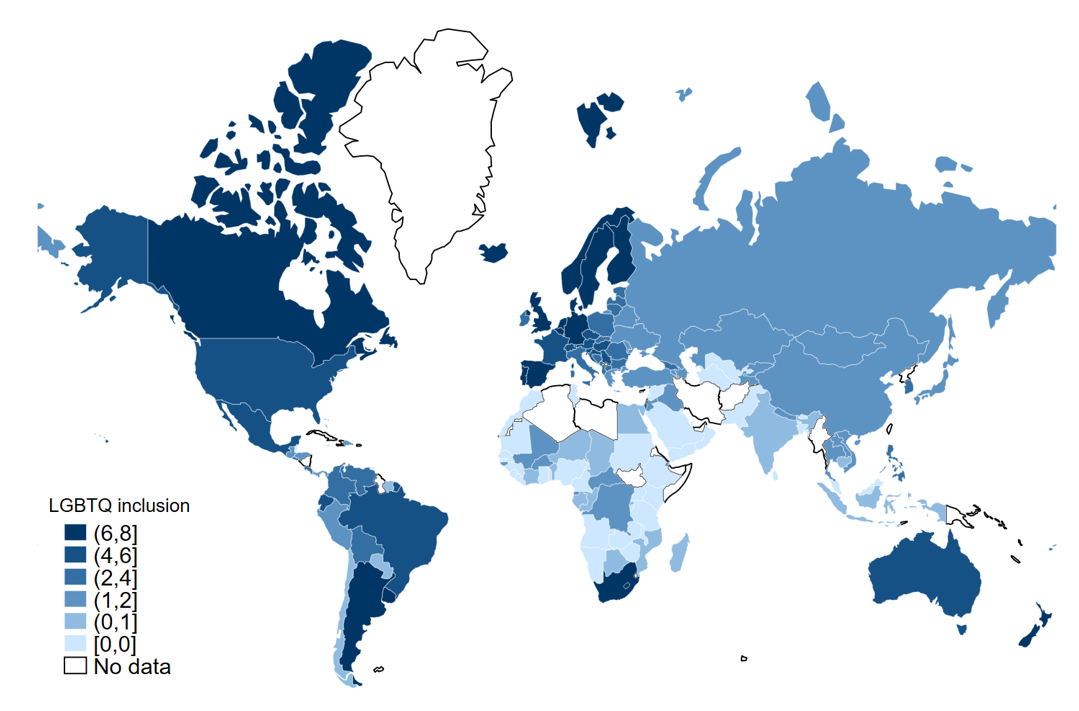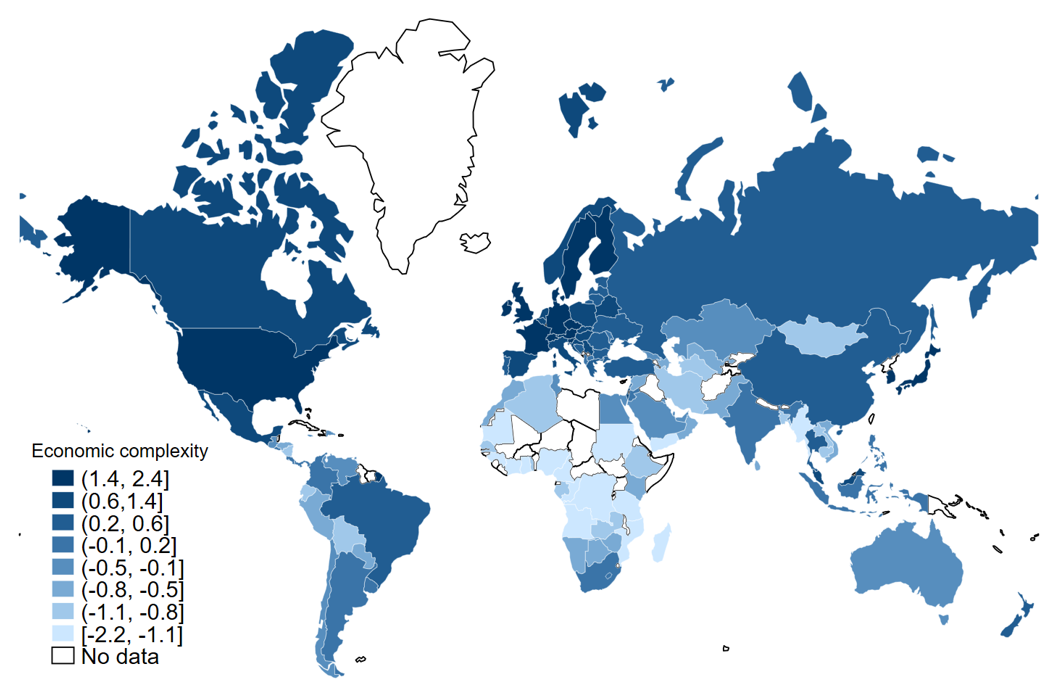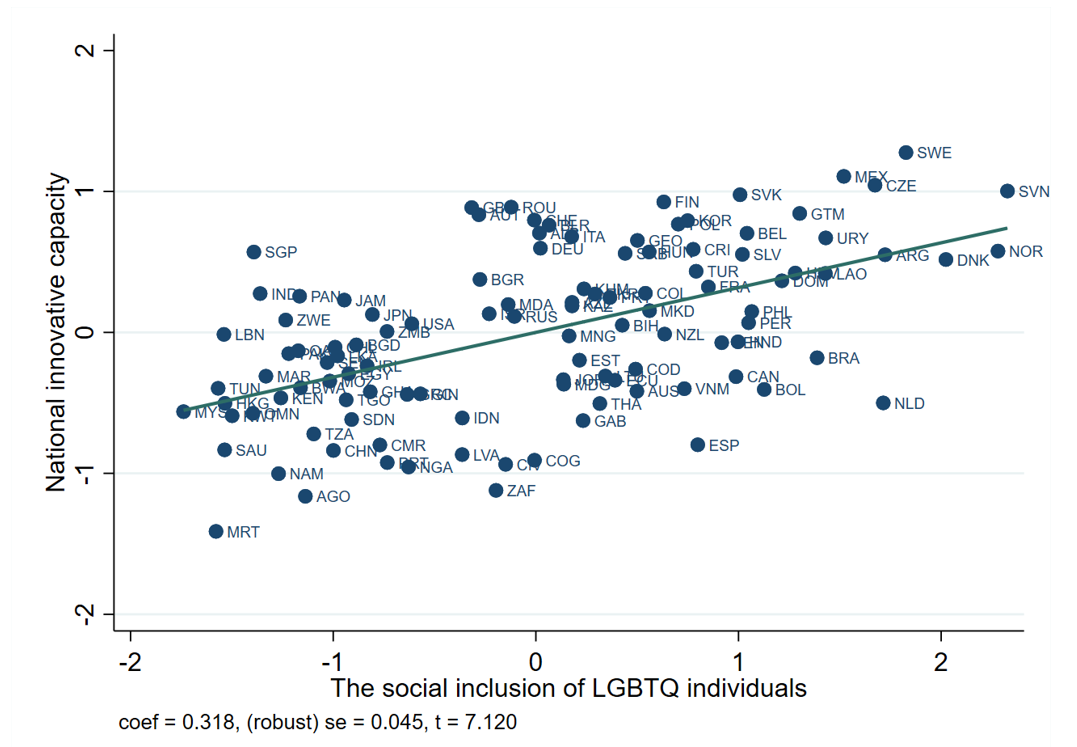Socially excluded groups can be as productive as anybody else and excluding them from the workplace may undermine firm-level productivity. Given that national innovation hinges upon the accumulation of better skills, Trung Vu finds empirical evidence that countries with stronger legal rights and protections for LGBTQ people are relatively more innovative.
There exists an overwhelming consensus among economists and policymakers that the social, economic, and political exclusion of women and other marginalised groups within a society is detrimental to economic development (Duflo, 2012; Knowles et al., 2002). However, discrimination against lesbian, gay, bisexual, transgender, and queer (LGBTQ) individuals remains a widespread social concern in many countries across the globe (Ayoub & Kollman, 2021; Badgett et al., 2019; Bailey et al., 2016).
Establishing an LGBTQ-inclusive environment requires a profound understanding of whether and how LGBTQ inclusion matters for socio-economic performance. Against this background, my research provides an empirical examination of the relationship between LGBTQ inclusion and national innovative capacity. It demonstrates that countries endowed with better legal rights and protections for LGBTQ people are characterised by greater innovative capabilities.
How does LGBTQ inclusion affect national innovation?
The positive relationship between LGBTQ inclusion and national innovation rests upon the argument that discrimination against LGBTQ individuals hampers the accumulation of better human capital skills. These individuals typically suffer from school harassment and assault, leading to higher rates of school dropout and lower educational attainment. By reducing discrimination in employment, legal rights and protections afforded to LGBTQ people foster their capabilities and skills. Workplace discrimination may undermine firm-level productivity if discriminatory employers refuse to recruit socially excluded groups who can be more or at least as productive as others. Given that national innovation hinges upon the accumulation of better skills, countries with stronger legal rights and protections of LGBTQ people may end up being relatively more innovative.
Creating an LGBTQ-inclusive environment signals social tolerance towards nonconformists, thereby enhancing innovative activities. LGBTQ inclusion reflects the social acceptance of diversity, creativity, and open-mindedness, which in turn reduces barriers to the inflows of talents and innovators. It follows from this line of reasoning that LGBTQ inclusion is positively associated with national innovative capacity across countries.
How to measure LGBTQ inclusion and national innovation?
To capture cross-country differences in LGBTQ inclusion, I use the global index on legal recognition of homosexual orientation provided by Badgett et al. (2019). It reflects the worldwide variation in legal rights implemented to reduce discrimination against LGBTQ individuals within a society, including (i) legality of consensual homosexual acts between adults, (ii) equal age limits for consensual homosexual and heterosexual acts, (iii) explicit legal prohibition of sexual orientation discrimination in employment, (iv) explicit legal prohibition of sexual orientation discrimination regarding goods and/or services, (v) legal recognition of the non-registered cohabitation of same-sex couples, (vi) availability of registered partnership for same-sex couples, (vii) possibility of second-parent and/or joint adoption by same-sex partners, and (viii) legal option of marriage for same-sex couples. Figure 1 depicts the cross-country variation in LGBTQ inclusion where darker areas correspond to countries and territories with greater LGBTQ inclusion.
Figure 1. Cross-country differences in LGBTQ inclusion

Source: reproduced from Vu (2022)
The variation in national innovative capacity across countries is measured by the economic complexity index of Hidalgo and Hausmann (2009). Economic complexity is a proxy for international differences in the availability of productive capabilities, reflected in the types of products a country can produce and export. More specifically, countries producing and exporting a diverse range of sophisticated (high-productivity) products, such as automobiles, electronics, and chemicals, are endowed with many hard-to-find productive capabilities and an improved capacity to assimilate and utilise existing productive knowledge to produce commercially valuable products. Therefore, countries with higher levels of economic complexity are characterised by better technological innovation. Figure 2 depicts the cross-country variation in economic complexity, where darker areas correspond to countries and territories with greater innovative capacity.
Figure 2. Cross-country differences in national innovative capacity
Source: reproduced from Vu (2022)
LGBTQ inclusion and innovation across countries
To provide empirical evidence of the relationship between LGBTQ inclusion and innovation, I regress the index of economic complexity on the measure of LGBTQ inclusion using data for up to 116 countries. The results indicate that LGBTQ inclusion is strongly correlated with higher levels of economic complexity, even when controlling for numerous potential confounding characteristics. As depicted in Figure 3, these findings are consistent with my prediction that countries with greater LGBTQ inclusion are endowed with more innovative capabilities, holding other things equal. Furthermore, I employ individual-level data from the World Values Survey and empirically establish that social acceptance of homosexuality is positively associated with surveyed respondents’ attitudes towards science and technology, new ideas, taking risks, and changes. These results also remain robust to controlling for various confounders.
Figure 3. The effect of LGBTQ inclusion on national innovative capacity across countries
Source: reproduced from Vu (2022)
The above results motivate exploring potential mechanisms underlying the positive relationship between LGBTQ inclusion and national innovation. For this purpose, I regress different measures of human capital on the index of LGBTQ inclusion and find that LGBTQ inclusion is a robust predictor of cross-country differences in the quality of human capital, which would be important for shaping the worldwide divergence in national innovative capacity.
The findings of my research help improve our understanding of how the inclusion of LGBTQ individuals contributes to economic performance across countries. Given that countries differ substantially in various dimensions of social, economic, and political development, I openly recognise the challenge with ruling out alternative explanations of cross-country differences in innovation. However, my findings at least partially motivate future research on the causal influence of LGBTQ inclusion on economic development around the world. This plays a central role in designing policy interventions towards reducing discrimination against LGBTQ people across countries.
♣♣♣
Notes:
- This blog post is based on Linking LGBT inclusion and national innovative capacity, Social Indicators Research.
- The post represents the views of its author(s), not the position of LSE Business Review or the London School of Economics.
- Featured image by Aiden Craver on Unsplash
- When you leave a comment, you’re agreeing to our Comment Policy.





